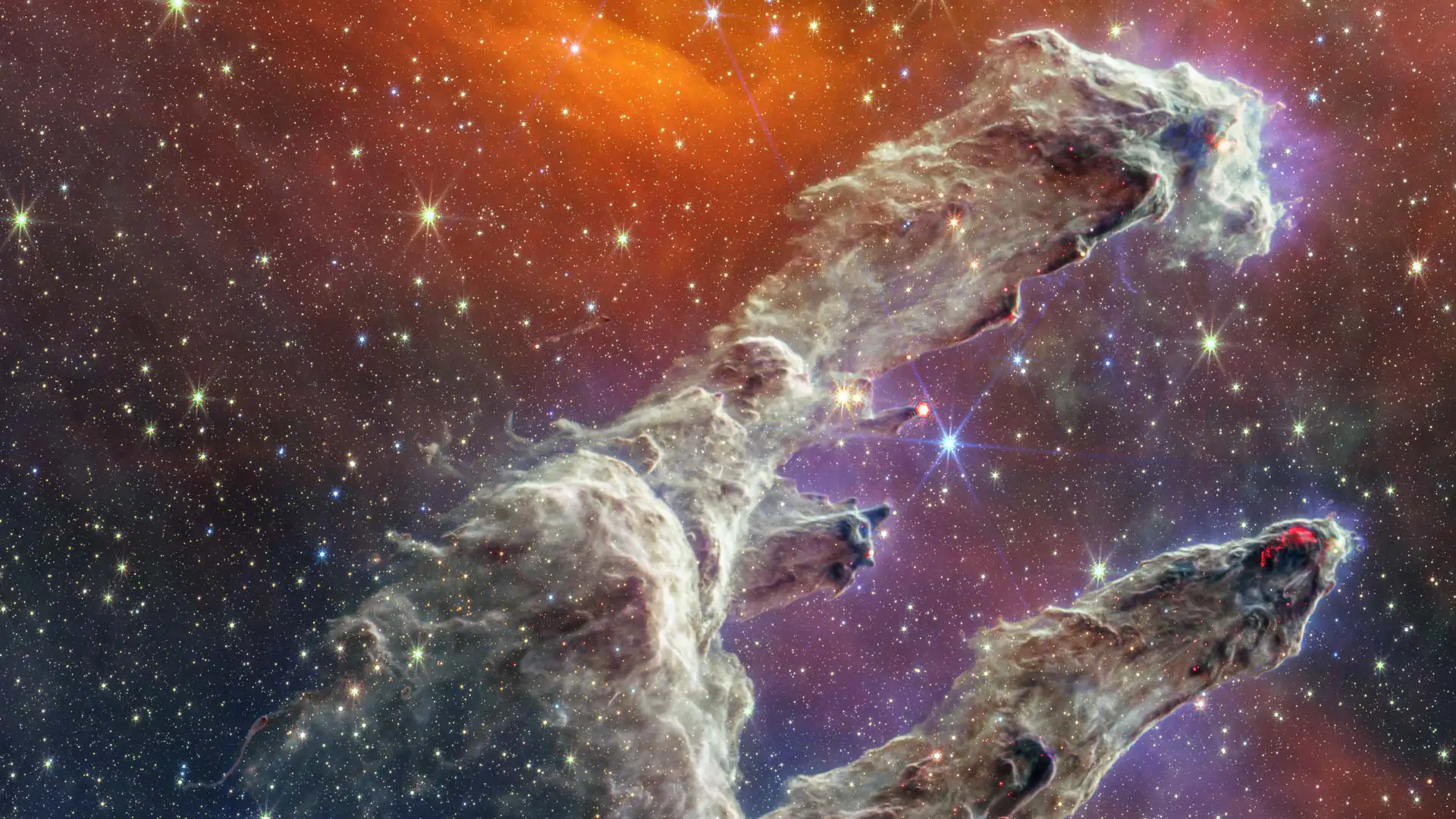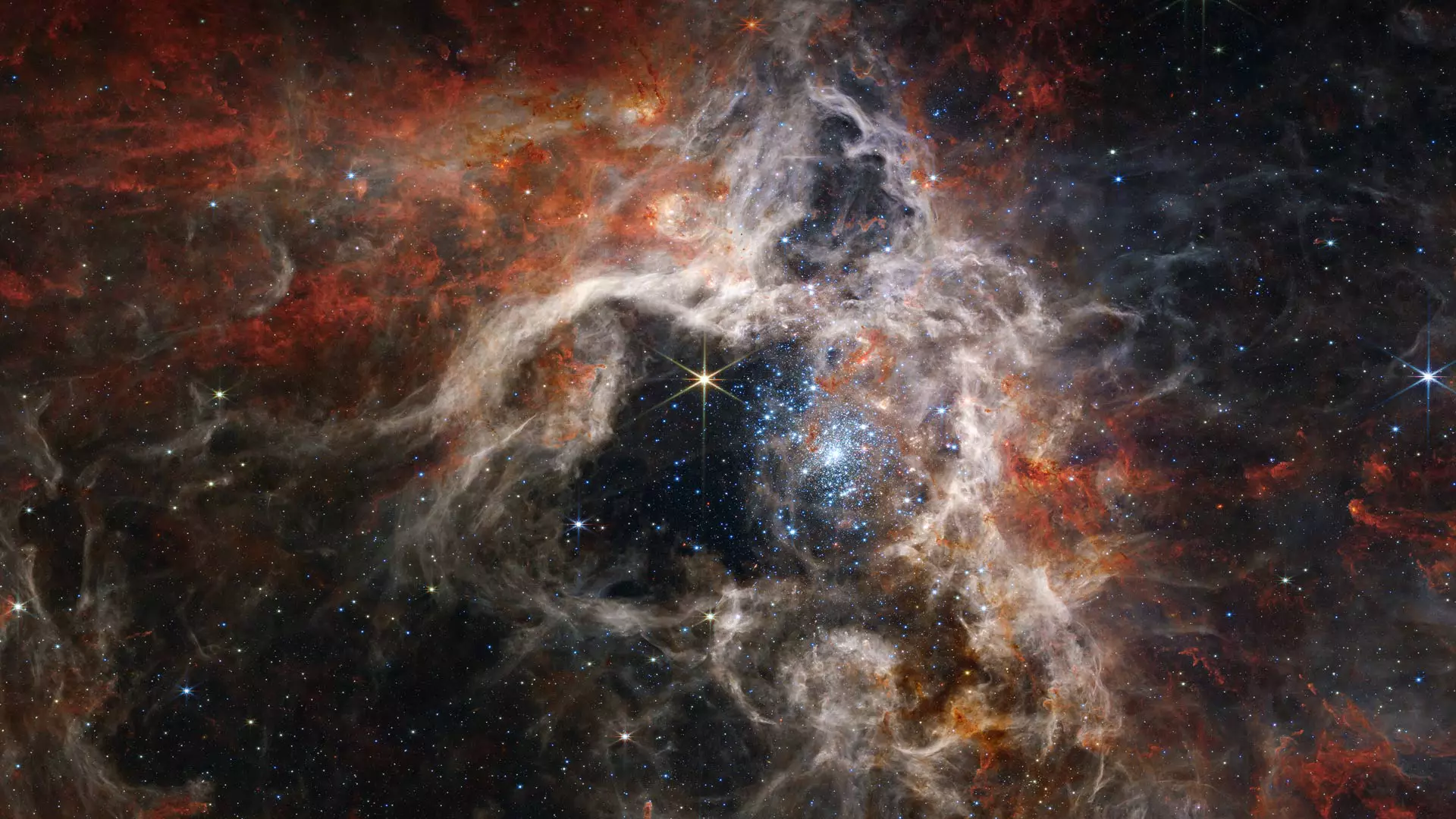詹姆斯·韦伯太空望远镜观测的创生之柱 The Pillars of Creation viewed by the James Webb Space Telescopev (© NASA)
詹姆斯·韦伯太空望远镜观测的创生之柱 The Pillars of Creation viewed by the James Webb Space Telescope (© NASA)
宇宙在绽放 Universe in bloom
太空周还没结束呢!
随着世界空间周接近尾声,宇宙依然不断给予我们仰望的理由。想象一下云朵——不是在天空中飘动,而是在浩瀚星海中延展,孕育着新星的诞生。这正是NASA的詹姆斯·韦布太空望远镜所捕捉到的“创生之柱”景象。如图所示,色彩与细节前所未见,令人震撼。
这些巨大的尖塔状结构,从左下角斜伸至右上角,几乎完全由尘埃和气体构成,这里正是恒星诞生的摇篮。在这些巍峨的结构内部,引力紧紧束缚着团块状的物质,逐步引发燃烧,从而孕育出新的恒星,它们已在柱体边缘闪烁生辉。令人惊叹的是,这一宇宙奇观正发生在距我们仅6500光年的鹰状星云中。这些柱体隐藏在遮蔽遥远宇宙的厚重星际云带之后,却依然绽放着璀璨的光芒,成为星云的焦点所在。
Space Week isn't over yet!
As World Space Week draws to a close, the cosmos continues to give us reasons to look up in awe. Picture clouds—not drifting across our skies, but stretching across space itself, cradling the birth of new stars. That's exactly what NASA's James Webb Space Telescope has revealed in its view of the Pillars of Creation—shown here—with colors and details unlike anything seen before.
These massive, spire-like structures—rising diagonally from bottom left to the top right—are composed almost entirely of dust and gas, the very seedbed of stars. Within these towering formations, gravity tightens its grip on knots of material, sparking gradual ignition and birthing new stars that already shimmer along the pillars' edges. Remarkably, this celestial performance is taking place just 6,500 light-years away, within the Eagle Nebula. Hidden behind thick lanes of interstellar clouds that mask the distant universe, the pillars emerge in full glory, shining front and center.
狼蛛星云中形成的年轻恒星,詹姆斯·韦布空间望远镜 Young stars forming in the Tarantula Nebula, James Webb Space Telescope (© NASA, ESA, CSA, STScI, Webb ERO Production Team)
狼蛛星云中形成的年轻恒星,詹姆斯·韦布空间望远镜 Young stars forming in the Tarantula Nebula, James Webb Space Telescope (© NASA, ESA, CSA, STScI, Webb ERO Production Team)
狼蛛星云 A spider's Webb of stars
世界太空周
每年10月4日至10日是世界太空周,可以让全世界的人了解太空探索和太空技术带来的诸多好处,并庆祝人类在地外取得的成就。其中令人惊叹的宇宙奇观是狼蛛星云,由美国宇航局的詹姆斯·韦伯太空望远镜拍摄。狼蛛星云是本星系群中最明亮、最大的恒星形成区,本星系群也是银河系的所在地。该星云巨大的体积和动态能量为宇宙学家和天文学家提供了大量引人注目的素材。
World Space Week
It's World Space Week, an opportunity to celebrate humanity's extraterrestrial achievements, as well as the benefits that come from space exploration and technology. The star of our homepage is actually a star-forming region known as the Tarantula Nebula, found in the same group of galaxies as our Milky Way. This detailed image was captured by the powerful James Webb Space Telescope and shows thousands of never-before-seen stars, previously obscured by cosmic dust. The nebula's colossal size and dynamic energy offer plenty of compelling material for astronomers and stargazers of all stripes.

